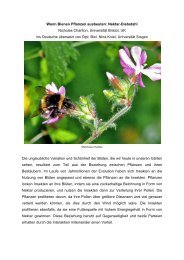PhDâ€theses - Ethologische Gesellschaft
PhDâ€theses - Ethologische Gesellschaft
PhDâ€theses - Ethologische Gesellschaft
You also want an ePaper? Increase the reach of your titles
YUMPU automatically turns print PDFs into web optimized ePapers that Google loves.
HEART RATE IN GREYLAG GEESE (ANSER ANSER): IMPLICATIONS FOR THE STUDY OF<br />
SOCIAL SYSTEMS<br />
Claudia A. F. Wascher<br />
claudia.wascher@klf.ac.at<br />
Research Update<br />
PhD thesis, supervised by Prof. Dr. K. Kotrschal, Konrad Lorenz Forschungsstelle, Universität Wien<br />
Social contexts are among the most potent stressors, affecting individual behaviour,<br />
physiology and the immune system. Although energetically costly, short‐term elevation of<br />
the stress response is adaptive and unavoidable in coping with challenges. In contrast<br />
chronic activation of the stress axes may have pathological consequences. Therefore, in<br />
terms of an individual’s fitness and well being, it is of major importance to respond to<br />
stressors adequately. However, not all members of a population are equally affected,<br />
individuals differ in their responses to stressors according their social embedding,<br />
personality, status, sex, age, etc.. In the course of my PhD I investigated the individual<br />
investment in the social domain as measured by heart rate (HR). I recorded HR of 25 greylag<br />
geese with fully implanted sensor‐transmitter packages for 18 months. Besides physical<br />
activity, social interactions proved to be the strongest HR modulators. In agonistic<br />
encounters HR increased to a greater extend, when the risk of being defeated was higher<br />
(e.g. in interactions with an opponent who wins a higher percentage of interactions). The<br />
present results suggest that individuals modulate their HR very flexible according to the<br />
relevance of single agonistic encounters. Even more impressive, HR was not only modulated<br />
by active involvement in stressful events, but also by watching interactions (“bystander<br />
effect”). Also here, the relevance of the event determines the immediate physiological<br />
response. Greylag geese responded stronger watching social (e.g. agonistic encounters,<br />
arriving or departing geese) than non‐social events (e.g. vehicles passing by, thunder).<br />
Furthermore, HR response differed, depending on the individuals involved in an event.<br />
Geese responded stronger when watching interactions, in which the pair‐partner or a family<br />
member was involved compared to events with non‐associated individuals. A similar picture<br />
appeared, when comparing HR responses to conspecifics vocalisations. HR was significantly<br />
higher if the pair‐partner called, compared to non‐associated geese. One of the key<br />
mechanisms to optimize the investment into the social domain is social support, which is<br />
defined as the stress‐reducing effect of the presence of a familiar social partner. Here, for<br />
the first time, effects of passive social support with respect to HR are reported in non‐human<br />
animals. In a stressful situation, unpaired individuals showed a significantly higher HR than<br />
paired individuals, which indicates that having a social ally, effects an individual’s physiology.<br />
To sum up, I found social events to have pronounced effects on an individual’s physiology.<br />
This may have serious consequences with respect to energy expenditure and probably may<br />
even affect an animal’s health or reproductive success. Still, individuals modulated their HR<br />
response according to the relevance of single events (e.g. risk of being defeated, social ally<br />
involved). Also, social support has been shown to have stress reducing effects with respect<br />
to HR. Therefore, living in social groups for greylag geese seems potentially energetically<br />
costly, but the individual investment is optimized by flexible modulation of the physiological<br />
stress response according to subsequent needs and requirements.<br />
9



